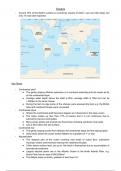Oceans
- Around 70% of the Earth’s surface is covered by oceans of which ⅕ are over 3km deep, but
only 1% has been explored
Key Terms
- Continental shelf
● The gently sloping offshore extension of a continent extending into the ocean as far
as the continental slope
● Average water depth above the shelf is 60m, average width is 70km but can be
>1000km in the Arctic Ocean
● During the last Ice Age some of the shelves were exposed dry land, e.g. the British
Isles and mainland Europe were connected
- Continental slope
● Where the continental shelf becomes stepper as it descends to the deep ocean
● The slope makes up less than 10% of oceans and it is not continuous due to
submarine canyons and gullies
● Many ocean plants and animals are found here including symbiotic coral reefs
● Lies 2-3km below the sea surface
- Continental rise
● The gently sloping ocean floor between the continental slope and the abyssal plain
● Only exists where the ocean bottom flattens to a gradient of 1o or less
- Abyssal plain
● The deepest part of the ocean covering vast areas of ocean floor, submarine
mountain chains and trenches interrupt the relatively flat plain
● 3-5km below surface level, but up to 1km thick in themselves due to accumulation of
land-derived sediment
● Largest abyssal plains are in the Atlantic Ocean in the North Atlantic Plain, e.g.
Sohm Plain has an area of 900,000km2
● The flattest areas on Earth, gradient of less than 0.5o
, Oceans
- Seamount
● A volcanic peak rising steeply from the ocean floor, some are isolated while others
occur in chains extending away from a mid-ocean ridge or hot spot
● Active or extinct with conical tops and steep sides than can rise of the 3km in the
ocean but do not reach the surface
- Guyot
● Flat-topped seamount with its summit well below the ocean surface, may appear to
have volcanic origin, formed at mid-ocean ridges
● Flattened due to water erosion and many were colonised by coral reefs before the
entire structure sunk below surface level, the weight of the guyot can make it
subside into the upper mantle
● The Pacific Ocean has thousands of guyots that rise from the abyssal plain
● Tend to have high levels of biodiversity and are therefore important to the fishing
industry
- Mid-oceanic ridge
● The boundary between two diverging oceanic plates, consists of two parallel chains
of submarine mountains separated by a graben and offset in places by transform
faults
● Can be up to 1,600km long, the Mid-Atlantic Ridge also grows by 1cm every year in
an East-West direction
● Hydrothermal vents can be found at ridges, these do not produce magma but
excrete heated water and minerals, incredibly important for the formation of life
- Rift valley
● A valley formed by downfaulting between parallel faults, examples are found on land
(East African Rift Valley) and along mid-oceanic ridges
● At a constructive plate boundary the plates move apart and magma rises to form
new land pushing the plates further
● The Mid-Atlantic Rift Valley is 15km wide in places
- Seafloor spreading
● Lateral movement of new oceanic crust away from a mid-ocean ridge (constructive
plate boundary), a key process in the theory of continental drift
- Paleomagnetism
● Traces of change in the Earth’s magnetic field in the alignment of magnetic minerals
and sedimentary and igneous rocks
, Oceans
- Subduction zone
● The tectonic process found at convergent plate margins where an oceanic plate
descends into the Earth’s mantle and is destroyed
- Trench
● A narrow deep depression on the ocean floor adjacent to the subduction zone
● Deepest regions in the Earth, can go 7-11km below the sea surface
● Associated with subduction of a dense oceanic plate beneath a continental plate at
destructive boundaries
● The deepest part of the ocean is the Challenger Deep in the Mariana Trench, Mount
Everest could fit into this fit 2km to spare on top
● Extremely hostile environment with temperatures just above freezing, no sunlight to
support photosynthesis and pressure 1,000x greater than at the surface, any
organisms that do live here are highly adapted with no bones or lungs
- Graben
● The downfaulted section of a rift valley
- As the Pacific Ocean is much younger than the other oceans of the world, and it is
constantly destroyed and created, there is far less sediment accumulation on the abyssal
plain, currents that would move the sediment into this area are also disrupted by oceanic
trenches
Hypsographic Curves
- The hypsometric or hypsographic curve is a cumulative height frequency curve for the
Earth’s surface
- It essentially shows the proportion of land area that exists at various elevations by plotting
relative area against relative height
- Roughly 70% of the Earth’s surface is below sea level, and the maximum depth (7,500m)
reached is much greater than the maximum elevation reached (4,000m)
- Less than 1% lies at a depth over 5,500m with the graph showing a much steeper gradient
as depth becomes more extreme




